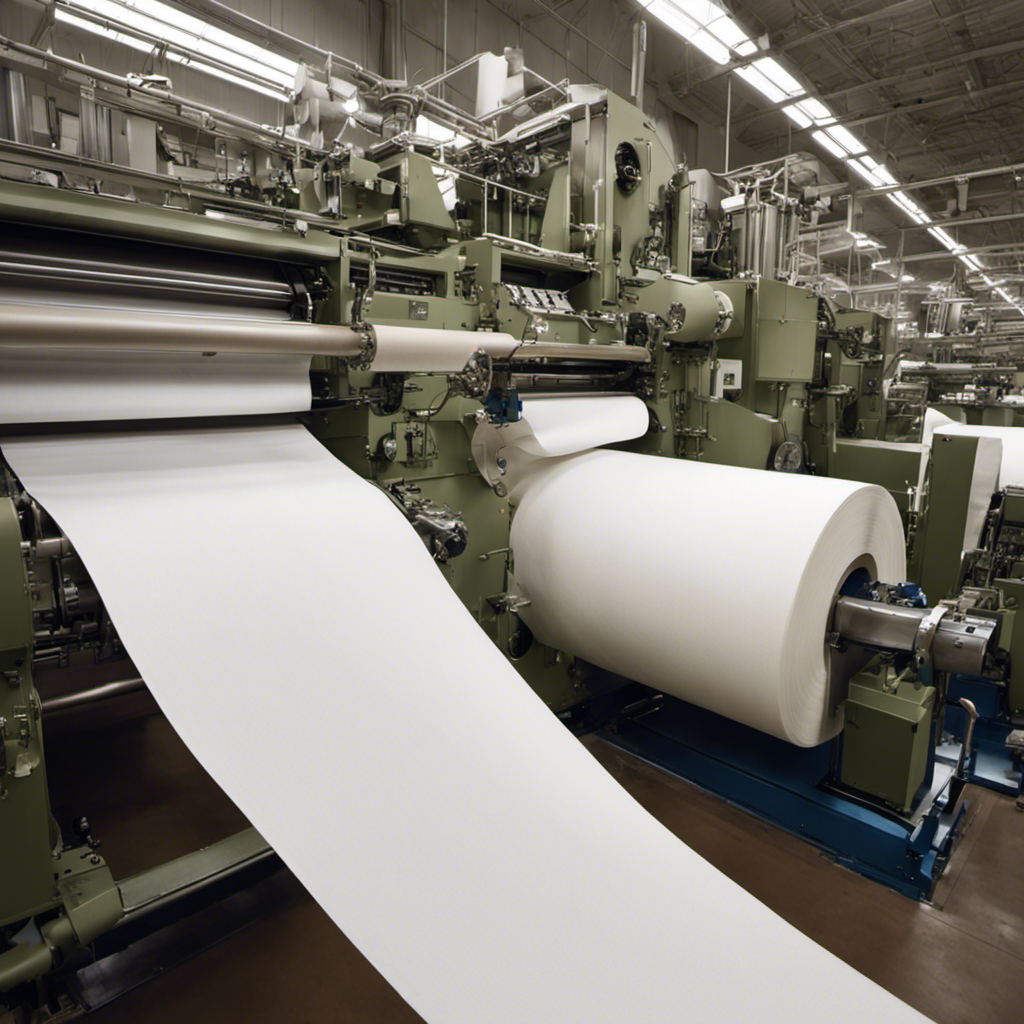Have you ever wondered how toilet paper is made?
Well, let me take you on a journey through the fascinating process of toilet paper production.
From the history of its manufacturing to the raw materials used, and the innovative enhancements made along the way, we will explore every step in a systematic and detailed manner.
So grab a seat and prepare to be amazed at the intricate and efficient process behind the creation of this essential everyday item.
Key Takeaways
- Toilet paper production originated in ancient China during the Tang Dynasty and was later commercially introduced in the United States by the Scott Paper Company.
- The raw materials used in toilet paper manufacturing include virgin wood pulp, recycled paper, bamboo, and bagasse.
- The papermaking process involves fiber selection, creating a slurry with water and chemicals, pouring it onto a wire mesh screen, pressing and drying the wet paper, and finally winding and cutting it into smaller rolls for packaging.
- Enhancements and innovations in toilet paper manufacturing include the use of recycled paper fibers, embossing technology for visual appeal and improved softness and strength, biodegradable packaging, and water-saving manufacturing techniques.
History of Toilet Paper Production
The history of toilet paper production can be traced back to ancient China. It is believed that the first recorded use of toilet paper dates back to the 6th century during the Tang Dynasty. At that time, toilet paper was made from soft materials such as bamboo, hemp, and rice straw.
As the years went by, toilet paper production techniques evolved, and different brands emerged. In the 19th century, the Scott Paper Company introduced the first commercially available toilet paper in the United States.
Today, toilet paper has become an essential part of our daily lives and holds cultural significance in many societies. It is considered a symbol of cleanliness and hygiene.
Now, let’s explore the raw materials used in toilet paper manufacturing.
Raw Materials Used in Toilet Paper Manufacturing
You can start by sourcing the raw materials used for manufacturing toilet paper. In toilet paper manufacturing, the fiber sources play a crucial role in determining the quality and texture of the final product. Here are four common fiber sources used in toilet paper production:
-
Virgin Wood Pulp: Obtained from trees, virgin wood pulp is the most widely used fiber source. It provides strength and softness to the toilet paper.
-
Recycled Paper: This fiber source is derived from post-consumer waste paper, such as newspapers and magazines. Recycling paper helps reduce environmental impact.
-
Bamboo: With its fast growth and high yield, bamboo is becoming a popular sustainable alternative to traditional fiber sources. It offers strength and softness to the toilet paper.
-
Bagasse: Bagasse is a byproduct of sugarcane processing. It is an eco-friendly fiber source that provides strength and absorbency to the toilet paper.
Toilet paper production techniques vary depending on the fiber source used. These techniques include pulping, bleaching, and drying, which result in the final product we use daily.
The Papermaking Process for Toilet Paper
When making toilet paper, it begins with understanding the papermaking process. The process involves fiber selection, where different types of fibers, such as wood pulp or recycled paper, are chosen based on the desired quality and softness of the final product.
Once the fibers are selected, they are mixed with water and chemicals to create a slurry. This slurry is then poured onto a wire mesh screen, and the water is drained away, leaving behind a wet sheet of paper.
The wet paper is then pressed and dried to remove any remaining water. The drying process can be done using heated rollers or by passing the paper through a series of heated cylinders.
After drying, the paper is wound onto large rolls. These rolls are then cut into smaller rolls to be packaged as toilet paper.
Enhancements and Innovations in Toilet Paper Manufacturing
Try exploring the enhancements and innovations in toilet paper manufacturing to learn about the latest advancements in the industry. Technological advancements and sustainable practices have revolutionized the way toilet paper is made, making it more efficient and environmentally friendly. Here are four exciting developments in toilet paper manufacturing:
-
Recycled fiber usage: Manufacturers are increasingly using recycled paper fibers to produce toilet paper, reducing the demand for virgin wood pulp and preserving natural resources.
-
Embossed patterns: Innovations in embossing technology have allowed for intricate and aesthetically pleasing patterns on toilet paper. This not only enhances the visual appeal but also improves the softness and strength of the paper.
-
Biodegradable packaging: Companies are now using biodegradable materials for packaging, reducing the environmental impact of toilet paper production and disposal.
-
Water-saving processes: Advanced manufacturing techniques have led to water-saving practices, minimizing water usage during the manufacturing process and contributing to sustainability efforts.
These advancements in toilet paper manufacturing demonstrate the industry’s commitment to technological progress and sustainable practices.
Environmental Considerations in Toilet Paper Production
Consider the environmental impact of using recycled fibers and biodegradable packaging in toilet paper manufacturing. Sustainable practices are becoming increasingly important in the production of everyday products, including toilet paper. By using recycled fibers, we can reduce the need for virgin materials and decrease the deforestation impact. Additionally, biodegradable packaging ensures that the waste generated from the product is also environmentally friendly. To illustrate the benefits of these practices, consider the following table:
| Sustainable Practice | Environmental Impact |
|---|---|
| Using recycled fibers | Reduces deforestation and conserves resources |
| Biodegradable packaging | Minimizes waste and promotes eco-friendly disposal |
Incorporating these sustainable practices into toilet paper manufacturing not only helps mitigate the environmental impact but also contributes to a more sustainable and responsible industry.
Conclusion
And there you have it, the fascinating journey of how toilet paper is made!
From its humble beginnings as a luxury item for the elite to its widespread availability in every household, the production of toilet paper has come a long way.
Through a meticulous process that involves cutting down trees, pulping the wood, and transforming it into soft, absorbent sheets, toilet paper is created with utmost precision.
With continuous advancements and innovations, toilet paper manufacturing has reached new heights of efficiency and comfort.
So next time you use a roll, remember the intricate system that brings this essential product to your bathroom.










